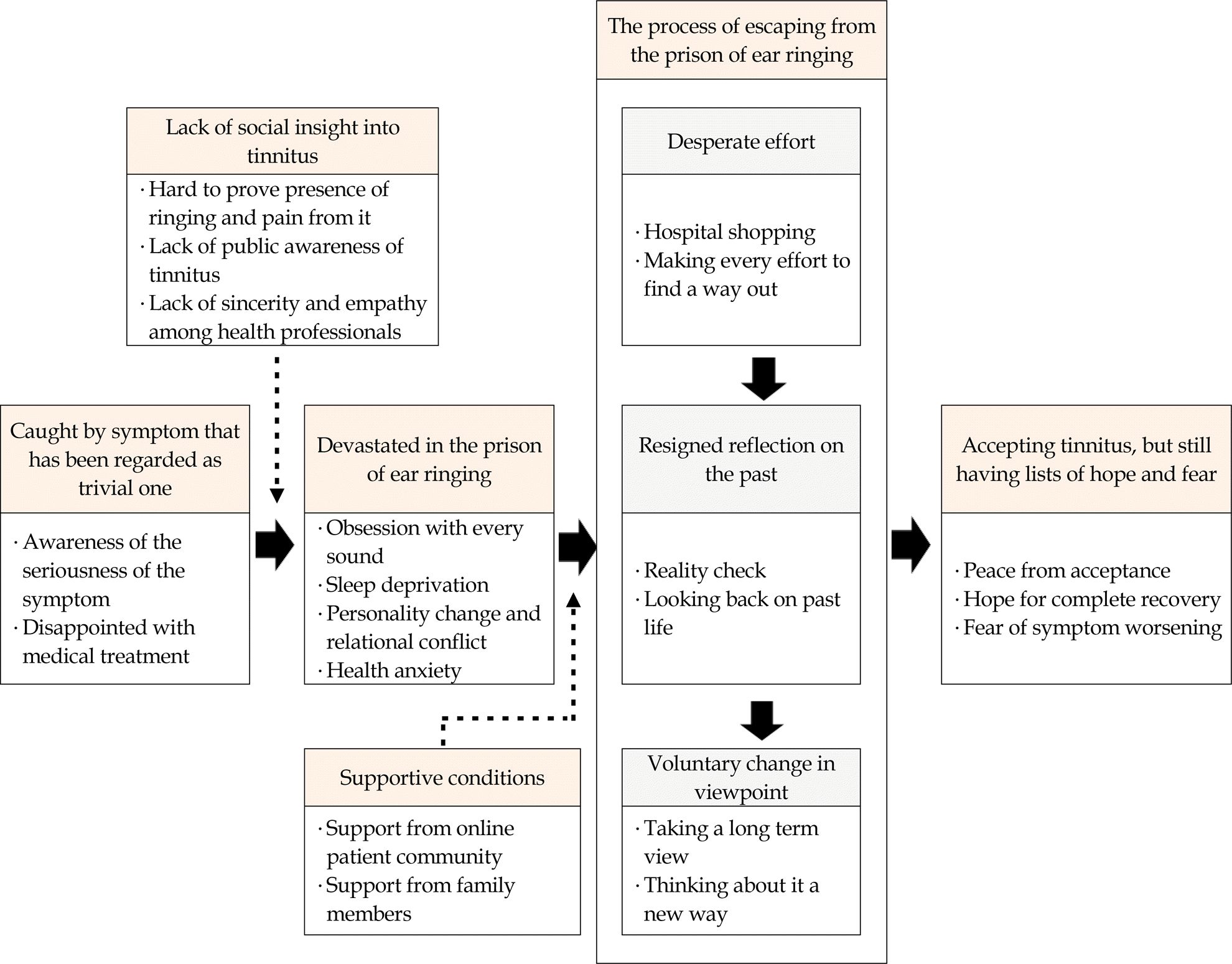Abstract
Purpose
The purpose of this study was to explore the process of symptom acceptance of tinnitus patients.
Methods
Data were collected from October 2017 to March 2018 through individual in-depth interviews with 15 tinnitus patients. Verbatim transcripts and field notes were analyzed using grounded theory methodology developed by Corbin and Strauss.
Results
The core category about the symptom acceptance of tinnitus patients was identified as “ accepting tinnitus as an alarming sign to escape from the prison of ear ringing and maintain good health.” The acceptance of tinnitus consisted of three phases: “ desperate effort”, “ resigned reflection on the past stage”, and “ voluntary change in viewpoint stage”.
Conclusion
The findings from this study show that tinnitus had a great impact on the life of the patients. The core category: “ accepting tinnitus as an alarming sign to escape from the prison of ear ringing and maintain good health” shows the agony and endeavor of the patients in the process of accepting the symptom as the part of their life amid lack of social insight into tinnitus. Healthcare providers’ cooperation is needed to build a supportive social atmosphere to help these patients empathetically and enhance their coping capabilities and symptom management. This finding will be helpful for developing educational programs and intervention guidelines and providing appropriate counseling services for these people.
Go to : 
REFERENCES
1. Cho Y-S, Choi S-H, Park KH, Park HJ, Kim J-W, Moon IJ, et al. Prevalence of otolaryngologic diseases in South Korea: data from the Korea national health and nutrition examination survey 2008. Clinical and Experimental Otorhinolaryngology. 2010; 3(4):183–93. https://doi.org/10.3342/ceo.2010.3.4.183.

2. Kim H-J, Lee H-J, An S-Y, Sim S, Park B, Kim SW, et al. Analysis of the prevalence and associated risk factors of tinnitus in adults. PLoS ONE. 2015; 10(5):e0127578. https://doi.org/10.1371/journal.pone.0127578.

3. Minen MT, Camprodon J, Nehme R, Chemali Z. The neuro-psychiatry of tinnitus: a circuit-based approach to the causes and treatments available. Journal of Neurology, Neurosurgery & Psychiatry. 2014; 85(10):1138–44. https://doi.org/10.1136/jnnp-2013-307339.

4. Ukaegbe OC, Orji FT, Ezeanolue BC, Akpeh JO, Okorafor IA. Tinnitus and its effect on the quality of life of sufferers: a Ni-gerian cohort study. Otolaryngology-Head and Neck Surgery. 2017; 157(4):690–5. https://doi.org/10.1177/0194599817715257.

5. Pinto PC, Sanchez TG, Tomita S. The impact of gender, age and hearing loss on tinnitus severity. Brazilian Journal of Otorhinolaryngology. 2010; 76(1):18–24. https://doi.org/10.1590/S1808-86942010000100004.
6. Bhatt JM, Bhattacharyya N, Lin HW. Relationships between tinnitus and the prevalence of anxiety and depression. The La-ryngoscope. 2017; 127(2):466–9. https://doi.org/10.1002/lary.26107.

7. Schecklmann M, Pregler M, Kreuzer PM, Poeppl TB, Lehner A, Crönlein T, et al. Psychophysiological associations between chronic tinnitus and sleep: a cross validation of tinnitus and insomnia questionnaires. BioMed Research International. 2015; 2015:461090. https://doi.org/10.1155/2015/461090.

8. Makar SK, Biswas A, Shatapathy P. The impact of tinnitus on sufferers in Indian population. Indian Journal of Otolaryngology and Head & Neck Surgery. 2014; 66(1):37–51. https://doi.org/10.1007/s12070-011-0291-x.

9. Moring J, Bowen A, Thomas J, Bira L. The emotional and functional impact of the type of tinnitus sensation. Journal of Clinical Psychological in Medical Settings. 2016; 23(3):310–8. https://doi.org/10.1007/s10880-015-9444-5.

10. Kramer F, Ortigoza Á. Ginkgo biloba for the treatment of tinnitus. Medwave. 2018; 18(6):e7295. https://doi.org/10.5867/medwave.2018.06.7294.
11. Rocha AV, Mondelli MFCG. Applicability of the real ear measurement for audiological intervention of tinnitus. Brazilian Journal of Otorhinolaryngology. 2018. Forthcoming.https://doi.org/10.1016/j.bjorl.2018.07.010.

12. Lee HM, Han KD, Kong SK, Nam EC, Park SN, Shim HJ, et al. Epidemiology of clinically significant tinnitus: a 10-year trend from nationwide health claims data in South Korea. Otology & Neurotology. 2018; 39(6):680–7.

13. Park DY, Kim HJ, Kim CH, Lee JY, Han K, Choi JH. Prevalence and relationship of olfactory dysfunction and tinnitus among middle- and old-aged population in Korea. PLoS ONE. 2018; 13(10):e0206328. https://doi.org/10.1371/journal.pone.0206328.

14. Corbin J, Strauss A. Basics of qualitative research: techniques and procedures for developing grounded theory. 4th ed.Thousand Oaks, CA: SAGE Publications;2015. p. 11–340.
15. Guba EG, Lincoln YS. Effective evaluation: improving the usefulness of evaluation results through responsive and naturalistic approaches. San Francisco, CA: Jossey-Bass Publishers;1981. p. 104–27.
16. Go Y, Park M. Effects of Subjective Hearing Handicap and Perceived Stress on Quality of Communication Life of Older Adults. Korean Journal of Adult Nursing. 2017; 29(5):496–504. https://doi.org/10.7475/kjan.2017.29.5.496.

17. Pinto PC, Sanchez TG, Tomita S. The impact of gender, age and hearing loss on tinnitus severity. Brazilian Journal of Otorhinolaryngology. 2010; 76(1):18–24. https://doi.org/10.1590/S1808-86942010000100004.
18. Salviati M, Bersani FS, Terlizzi S, Melcore C, Panico R, Romano GF, et al. Tinnitus: clinical experience of the psychosomatic connection. Neuropsychiatric Disease and Treatment. 2014; 10:267–75. https://doi.org/10.2147/ndt.s49425.
19. Pan T, Tyler RS, Ji H, Coelho C, Gogel SA. Differences among patients that make their tinnitus worse or better. American Journal of Audiology. 2015; 24(4):469–76. https://doi.org/10.1044/2015_aja-15-0020.

20. Kim H-Y, Eom C-H. Search for humanities therapy utilizing oral history: memory, trauma and history therapy. Studies in Humanities. 2010; 24:361–83.
21. Hoekstra CEL, Wesdorp FM, van Zanten GA. Sociodemographic, health, and tinnitus related variables affecting tinnitus severity. Ear and Hearing. 2014; 35(5):544–54. https://doi.org/10.1097/AUD.0000000000000045.

22. Nascimento IP, Almeida AA, Diniz Junior J, Martins ML, Frei-tas TM, Rosa MR. Tinnitus evaluation: relation among pitch matching and loudness, visual analog scale and tinnitus handicap inventory. Brazilian Journal of Otorhinolaryngology. 2018. https://doi.org/10.1016/j.bjorl.2018.05.006.
23. Araujo TM, Iório MCM. Effects of sound amplification in self- perception of tinnitus and hearing loss in the elderly. Brazilian Journal of Otorhinolaryngology. 2016; 82(3):289–96. https://doi.org/10.1016/j.bjorl.2015.05.010.
24. Conrad I, Kleinstauber M, Jasper K, Hiller W, Andersson G, Weise C. The Role of dysfunctional cognitions in patients with chronic tinnitus. Ear and Hearing. 2015; 36(5):e279–89.

25. Beukes EW, Baguley DM, Allen PM, Manchaiah V, Andersson G. Audiologist-guided Internet-based cognitive behavior therapy for adults with tinnitus in the United Kingdom: a randomized controlled trial. Ear and Hearing. 2018; 39(3):423–33. https://doi.org/10.1097/aud.0000000000000505.

Go to : 




 PDF
PDF ePub
ePub Citation
Citation Print
Print



 XML Download
XML Download